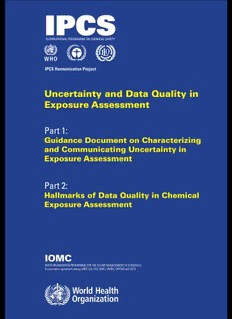
Uncertainty and Data Quality in Exposure Assessment: Part 1: Guidance Document on Characterizing & Communicating Uncertainty in Exposure Assessment. Part ... Data Quality in Chemical Exposure Assessment PDF
175 Pages·2009·1.372 MB·English
Most books are stored in the elastic cloud where traffic is expensive. For this reason, we have a limit on daily download.
Preview Uncertainty and Data Quality in Exposure Assessment: Part 1: Guidance Document on Characterizing & Communicating Uncertainty in Exposure Assessment. Part ... Data Quality in Chemical Exposure Assessment
Description:
Assessment of human exposure to chemicals is a critical input to risk assessment and ultimately to decisions about control of chemicals. This two-part publication aims to improve the quality of information available to decision-makers and its communication. Part One sets out ten principles for characterizing and communicating uncertainty in exposure assessment. A tiered approach to the evaluation of uncertainties using both qualitative (simple) and quantitative (more complex) methods is described. Different sources of uncertainty are identified, and guidance is provided on selecting the appropriate approach to uncertainty analysis, as dictated by the objectives of the assessment and information needs of decision-makers and stakeholders. Part Two addresses the quality of data used in exposure assessment, and sets out four basic hallmarks of data quality—appropriateness, accuracy, integrity and transparency. These hallmarks provide a common vocabulary and set of qualitative criteria for use in the design, evaluation and use of exposure assessments to support decisions.
See more
The list of books you might like
Most books are stored in the elastic cloud where traffic is expensive. For this reason, we have a limit on daily download.
